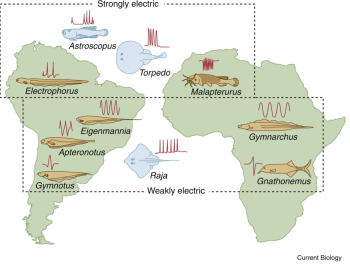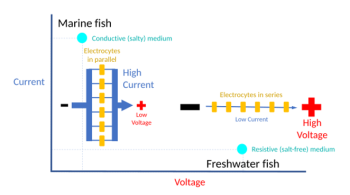By Vidya Rajan, Columnist, The Times
 All living organisms are electric, since it is electricity – the movement of electrons – that powers life with energy. Then that energy, obtained from light or food, can be used to move molecules around the body or join atoms to make new molecules. That, in summary, is the process of metabolism. Rather than examining metabolic processes in this article, I will look at conspicuous electricity generation or perception by animals that allow them to obtain food or ward off predators. Electrogenic cells in these animals have nerve or muscle origins, since these cells have the capacity to generate electricity in all living organisms. Most electricity generating animals are aquatic, but a couple – the echidna and Asian hornet – are terrestrial.
All living organisms are electric, since it is electricity – the movement of electrons – that powers life with energy. Then that energy, obtained from light or food, can be used to move molecules around the body or join atoms to make new molecules. That, in summary, is the process of metabolism. Rather than examining metabolic processes in this article, I will look at conspicuous electricity generation or perception by animals that allow them to obtain food or ward off predators. Electrogenic cells in these animals have nerve or muscle origins, since these cells have the capacity to generate electricity in all living organisms. Most electricity generating animals are aquatic, but a couple – the echidna and Asian hornet – are terrestrial.
In the 1770s, the Royal Society in London was the premier scientific institution in the world, and the eighteenth century was the time when electricity was the new scientific frontier. Inventions to generate and store the ‘static’ generated by rubbing amber — ‘elektra’ in Greek – were reported. One of the pioneers of the study of electricity was Philadelphia’s very own Benjamin Franklin, who won the prestigious Copley Medal in 1753 “On account of his curious Experiments and Observations on Electricity’. But a startling revelation was that an animal, specifically the torpedo fish Torpedo torpedo, could produce and deliver a shock just like one from a Leyden jar. Although this ability had been known for millennia, it had not been previously understood that it produced the same sort of electricity as Franklin’s lightning. The learned fellows of the Society were agog. They could not understand how an animal could deliver a shock so powerful without killing itself, especially given that it lived in salty water which conducts electricity. Other electric fish were discovered, and later classified into the strongly electric, and weakly electric fish (Figure 1).[1]

Figure 1: Types of electric fish. Species of electric fish can be found in freshwater rivers of Africa and South America, as well as marine environments. Marine species are depicted in blue, freshwater species in yellow. Strongly electric fish use electricity to stun their prey, while weakly electric fish use electricity for sensing and communication. The waveform above each fish represents the time course of the electric organ discharge that would be recorded in the water near the fish.[2]
With the development of better microscopic methods, electrocytes were shown to have nerve or muscle origin. Typically, 700 modified cells are arranged in 45 columns within each electric organ. Each flattened electrocyte has two different types of channels. On one surface of the cell are sodium-potassium pumps and on the other surface are sodium channels. When the brain sends out a signal to discharge, the posterior sodium channels are activated first and start pushing out sodium ions and thereby creating a localized negative charge; then sodium-potassium channels are activated, allowing positively charged sodium ions to flow into the cell. This causes the anterior side of each cell to become highly positively charged and the posterior side to become highly negative. The potential difference between the two faces drives the movement of current. The current generated by each face is multiplied by the numbers of stacks, up to about 200 volts. For comparison, the voltage of a regular household outlet is 110 volts. In its ambush predator lifestyle, the torpedo delivers enough oomph to temporarily stun its fishy food. An analogous mechanism operates in the stargazer fish, Astroscopus guttatus,[3] albeit they produce electricity in their eye muscles and use it to stun prey, or use it for defense should it perceive itself to be the prey.
A more refined strategy is used by the also ‘strongly electric’ electric eel when hunting. Despite its name, the electric eels are grouped as ‘knifefishes’ and are more closely related to catfishes and carp (Gymnotiformes) than to true eels (Anguilliformes). First, it sends out strong pulses of around 600 volts which cause its prey’s muscles to twitch, revealing its location if it is hiding. Once located, the prey is subjected to higher voltage discharges (up to 800 volts with 1 ampere of current) which causes its muscles to spasm or freeze. The prey is now both toast and sashimi. It is not clear how come the eel does not short circuit or stop its own heart, but hypotheses range from the extremely short duration of discharge (2 milliseconds) and the presence of fatty adipose tissue which insulates the heart and muscles from the discharge.

Figure 2: There are three electricity-generating organs in the electric eel: The main organ produces the big punch of around 600 volts, the Hunter’s organ (discovered by the fortuitously named John Hunter, FRS[4]) produces around 40-60 volts, while the Sachs’ organ produces weak currents. The reason for the presence of three different electric organs is not clear.
Electricity emanating from living organisms is sensed by organs called electroreceptors. They identify the strength and direction of electrical charges that all living organisms produce. The Peters elephant-nosed fish has a ‘schnauzenorgan’ on its schnozz, whereas the antipodean monotremes[6]: the aquatic duck-billed platypus and the terrestrial echidna use sensors on their bill or beak to seek out prey in water or on land. The Asian hornet generates, rather than merely senses, electricity. The yellow pigment xanthopterin in the bands on its abdomen harvests solar energy to power the hornet’s digging and other activities.[7]

Figure 1: There are three electricity-generating organs in the electric eel: The main organ produces the big punch of around 600 volts, the Hunter’s organ (discovered by the fortuitously named John Hunter, FRS[4]) produces around 40-60 volts, while the Sachs’ organ produces weak currents. The reason for the presence of three different electric organs is not clear.
References:
[1]. Nelson, Mark E. Electric fish. Current Biology, Volume 21, Issue 14, R528 – R529. https://www.cell.com/current-biology/fulltext/S0960-9822(11)00349-6
[2]. Reproduced from: https://www.cell.com/current-biology/fulltext/S0960-9822(11)00349-6 under fair use copyright for educational purposes. Figure is modified from Moller, P. (1995). Electric Fishes: History and Behavior (London: Chapman and Hall) and reproduced in the original article with kind permission from Springer Science and Business Media B.V.
[3]. Wikipedia Contributors (2025). Astroscopus guttatus. Wikipedia. https://en.wikipedia.org/wiki/Astroscopus_guttatus
[4]. Internet Archive. (1775). An Account of the Gymnotus Electricus. By John Hunter, F. R. S.: Hunter, J.: Free Download, Borrow, and Streaming : Internet Archive. [online] Available at: https://archive.org/details/philtrans01229060
[5]. Cooney, P. (2013). Anadromous, Catadromous, Amphidromous, Oceanodromous, or Potamodromous. [online] The Fisheries Blog. Available at: https://thefisheriesblog.com/2013/05/20/anadromous-catadromous-amphidromous-oceanodromous-or-potamodromous/
[6]. Mammals are divided into three great groups: monotremes, marsupials and placentals. Monotremes and marsupials are non-placental mammals. Monotremes lay eggs and incubate them. However, once the young hatch, they are nourished with a milky fluid that is secreted from skin on the mother’s body. Marsupials also lack an internal placenta; their eggs hatch inside the body, but the tiny embryos crawl out and up to the mammary glands in the pouch where they mature. Placental mammals hatch and develop inside the mother’s body. They birth at different rates: in many herbivores, newly birthed offspring can run within hours of birth, but in primates the young are dependent on the mother for several years.
[7]. Bbc.co.uk. (2015). BBC – Earth News – Oriental hornets powered by ‘solar energy’. [online] Available at: http://news.bbc.co.uk/earth/hi/earth_news/newsid_9254000/9254445.stm
[8]. Clarke, D., Whitney, H., Sutton, G. and Robert, D., 2013. Detection and learning of floral electric fields by bumblebees. Science, 340(6128), pp.66-69. DOI: 10.1126/science.123088
[9]. Yoshida, K.S. (2013). Bees can sense—and learn from—the electric fields of flowers. [online] Ars Technica. Available at: https://arstechnica.com/science/2013/02/bees-can-senseand-learn-fromthe-electric-fields-of-flowers/







